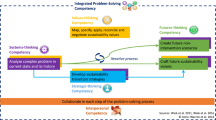Abstract
With increased demands for institutional accountability and improved student learning, involvement in assessment has become a fundamental role of higher education faculty (Rhodes, 2010). However, faculty members and administrators often question whether assessment efforts do indeed improve student learning (Hutchings, 2010). This mixed methods case study of a faculty inquiry project explored how factors linked to organizational context (Kezar, 2013) are related to commitment to assessment and to use of assessment data by faculty members. Results indicated key best practices, such as developing faculty leaders and communities of practice to exchange ideas. The study provides insights for institutional administrators and faculty members seeking to develop a culture of assessment.
Similar content being viewed by others

References
Blankenship, E., Martens, S., Stenberg, S., & Wilson, D. (2011). Teagle and Spencer final report: Assessing student learning. New York, NY: Teagle/Spencer. Retrieved from http://assessment.aas.duke.edu/documents/UN-LTeagleandSpencerFinalReport.pdf
Blankenship, E., Stenberg, S. J., & Wilson, D. E. (2013). Developing a process for assessing general education learning outcomes across a multicollege university. In R. J. Thompson Jr. (Ed.), Changing the conversation about higher education (pp. 113–127). Lanham, MD: Rowman & Littlefield.
Creswell, J. W., & Plano Clark, V. L. (2011). Designing and conducting mixed methods research (2nd ed.). Thousand Oaks, CA: Sage.
Dervin, B. (1999). Chaos, order, and sense-making: A proposed theory for information design. In R. Jacobson (Ed.), Information design (pp. 35–57). Cambridge, MA: MIT Press.
Greene, J. C., Caracelli, V. J., & Graham, W. F. (1989). Toward a conceptual framework for mixed-method evaluation designs. Educational Evaluation and Policy Analysis, 11, 255–274. doi:10.3102/01623737011003255
Hutchings, P. (2010, April). Opening doors to faculty involvement in assessment (NILOA Occasional Paper No. 4). Urbana, IL: University of Illinois and Indiana University, National Institute for Learning Outcomes Assessment. Retrieved from http://www.learningoutcomeassessment.org/occasionalpapers.htm
Hutchings, P., Ewell, P., & Banta, T. (2012). AAHE principles of good practice: Aging nicely. Urbana, IL: University of Illinois and Indiana University, National Institute for Learning Outcomes Assessment. Retrieved from http://www.learningoutcomeassessment.org/PrinciplesofAssessment.html#AAHE
Jonson, J. L., & Thompson, R. J., Jr. (2013). Assessment approaches and perspectives: Engaging faculty and improving student learning. In R. J. Thompson Jr. (Ed.), Changing the conversation about higher education (pp. 95–112). Lanham, MD: Rowman & Littlefield.
Jonson, J. L., Guetterman, T., & Thompson, R. J. (2014). An integrated model of influence: Use of assessment data in higher education. Research and Practice in Assessment, 9(1), 18–30.
Kezar, A. (2013). Institutionalizing student outcomes assessment: The need for better research to inform practice. Innovative Higher Education, 38, 189–206.
Kuckartz, U. (2014). Qualitative text analysis: A guide to methods, practice and using software. London, England: Sage.
Ndoye, A., & Parker, M. A. (2010). Creating and sustaining a culture of assessment. Planning for Higher Education, 38(2), 28–39.
Palomba, C. A. (2001). Implementing effective assessment. In C. A. Palomba & T. W. Banta (Eds.), Assessing student competence in accredited disciplines (pp. 13–28). Sterling, VA: Stylus.
Peterson, M. W., Einarson, M. K., Augustine, C. H., & Vaughan, D. S. (1999). Institutional support for student assessment: Methodology and results of a national survey. Stanford, CA: Stanford University, National Center for Postsecondary Improvement.
Peterson, M. W., & Einarson, M. K. (2001). What are colleges doing about student assessment? Does it make a difference? The Journal of Higher Education, 72, 629–669.
Rhodes, T. L. (2010). Assessing outcomes and improving achievement: Tips and tools for using rubrics. Washington, DC: Association of American Colleges and Universities.
Rodgers, M., Grays, M. P., Fulcher, K. H., & Jurich, D. P. (2012). Improving academic program assessment: A mixed methods study. Innovative Higher Education, 38, 383–395.
Spillane, J. P., Halverson, R., & Diamond, J. B. (2001). Investigating school leadership practice: A distributed perspective. Educational Researcher, 30, 23–28.
University of Nebraska-Lincoln (2014). Achievement-centered education. Retrieved from ace.unl.edu
Verbi GmbH. (2014). MAXQDA (Version 11) [Software]. Available from http://www.maxqda.com/
Walvoord, B. E. (2010). Assessment clear and simple: A practical guide for institutions, departments, and general education (2nd ed.). San Francisco, CA: John Wiley.
Yin, R. K. (2014). Case study research: Design and methods (5th ed.). Thousand Oaks, CA: Sage.
Author information
Authors and Affiliations
Corresponding author
Rights and permissions
About this article
Cite this article
Guetterman, T.C., Mitchell, N. The Role of Leadership and Culture in Creating Meaningful Assessment: A Mixed Methods Case Study. Innov High Educ 41, 43–57 (2016). https://doi.org/10.1007/s10755-015-9330-y
Published:
Issue Date:
DOI: https://doi.org/10.1007/s10755-015-9330-y



